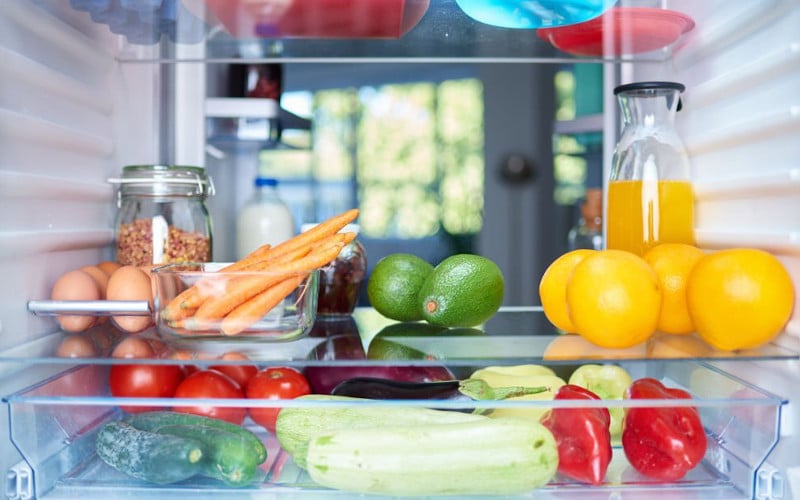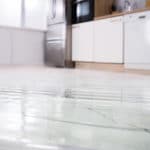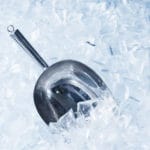If your Samsung freezer is not working, you are not alone. This is a common problem that many people experience. There are several things that you can do to try to fix the problem.
In this blog post, I will discuss some of the most common causes of this issue and provide solutions to help you get your freezer up and running again.
Freezer Door Is Not Sealed
When your Samsung freezer isn’t cooling as it used to, double-check that the door seal hasn’t worn down. The seals on the doors may deteriorate with time, allowing warm air in. This leads to the all-too-familiar issue of ice buildup accumulating in your freezer due to a lack of proper ventilation.
However, in this situation, replacing the seals is a straightforward procedure. Cleaning the seal is always a good idea. Debris, dust, or crumbs might cause grooves to form in the seal. These groves restrict the freezer door from fully shutting, allowing humid air to enter.
You may check if the cleaning helped by placing a dollar bill on the freezer door seal’s edge. Simply lay the dollar bill on the freezer door’s edge and shut it. Then remove the dollar bill from the door. If you encounter difficulty pulling out the dollar, don’t replace its seal. But if there is no resistance when you pull it out, then it is time to replace the seal.
You may also check if your freezer door’s hinges are broken or not working properly. If you find that they’re cracked and not operating effectively, go ahead and fix them with a repair kit. The same goes for loose bolts on top of the freezer doors and/or sides-tighten them up.
Condenser Coils are Dirty
If the coils are not within the freezer’s walls, clean them to determine if they are filthy. They are most likely dirty. As a result, clean them properly in order for them to dissipate the heat from the freezer effectively. Otherwise, the freezer won’t be able to freeze food properly.
Every 6 to 12 months, the condenser coils should be cleaned. Doing so ensures that they are in top form to do their job effectively.
Evaporator Coils Are Frosted Over
When the evaporator coils are coated with frost, the evaporator fan cannot circulate cold air within the fridge because of obstruction, and the refrigerator will not be cooling.
This issue is due to a failed to defrost cycle. The problem may sometimes be resolved by replacing the defrost temperature sensor (but it is not always successful).
There are actually two identical temperature sensors. One with the white connector on the right side of the refrigerator, however, is required.
If the drain is blocked during the defrost cycle (the drain is fully or partially clogged), you will have standing water at the bottom. The evaporator fan on the top portion of the twin cooling panel freezes up as a result of standing water evaporating and condensing in the upper section.
Water in or under the crisper drawers, as well as your Samsung refrigerator leaking because the drain line is blocked and water is overflowing, are all symptoms of this problem.
Debris in the Freezer Vents
The freezer vents, like the condenser coils, can get clogged. You should inspect them on a regular basis to look for any accumulation of particles. Vents must be free of debris or other objects in order to function properly.
For example, keeping packages and food close to the vent will obstruct ventilation. Hot, humid air builds up and forms frost as a result of this. The freezer may not get cold enough if this buildup persists.
Related: How to Clean a Samsung Refrigerator?
Evaporator Fan Frosted Over
The fan’s main function is to distribute cold air throughout the fridge. However, if your Samsung fridge isn’t cooling, one of the reasons could be that an ice blockage has jammed up your evaporator fan.
Close the left door of your french-door refrigerator and attach a common magnet to the right side to simulate the closing of the right door. The evaporator fan should start spinning after a few seconds.
If you don’t hear the fan, it’s probable that ice has clogged the fan blades or that it is burnt out.
Weak or Defective Defrost Heater
In most cases, the defrost heater assembly (you may get one here) is in charge of defrosting any frost that has grown on the evaporator coils in the refrigerator, which is responsible for allowing cold air to freely flow and help to cool down the freezer.
When the defrost heater assembly is not working correctly, extra frost will accumulate on the evaporator coils, resulting in a restricted airflow and an un-cooled refrigerator.
Defective Thermistor Or Temperature Sensor
This component maintains the temperature of the refrigerator and transmits information from the thermometer to the control board, allowing for proper cooling by means of the evaporator fan and compressor.
When the thermistor is faulty, both the compressor and evaporator fan may not function correctly.
Failed Defrost Thermostat
The power supply to the heater is provided by this component. When it malfunctions, electricity will not flow and the heater won’t be able to heat up and remove ice or frost from the evaporator coils.
Failed Display and Main Control Boards
Burns may be caused by overheating, but they are more frequently caused by the user control and display board. If burns are found, it suggests the components have been damaged.
Even if there are no burns, check to see whether they are still operational. If you cannot do this yourself, have a refrigerator technician perform the test for you. The freezer won’t function if any of the boards are damaged. As soon as feasible, replace them.
Conclusion
If your Samsung refrigerator isn’t working, you may be concerned about food waste. However, if you know what to look for, repairing the problem takes very little time. As a result of this article, therefore, you will learn what to check for and how to repair them.
If you’re unsure how to repair them, contact Samsung for assistance.






